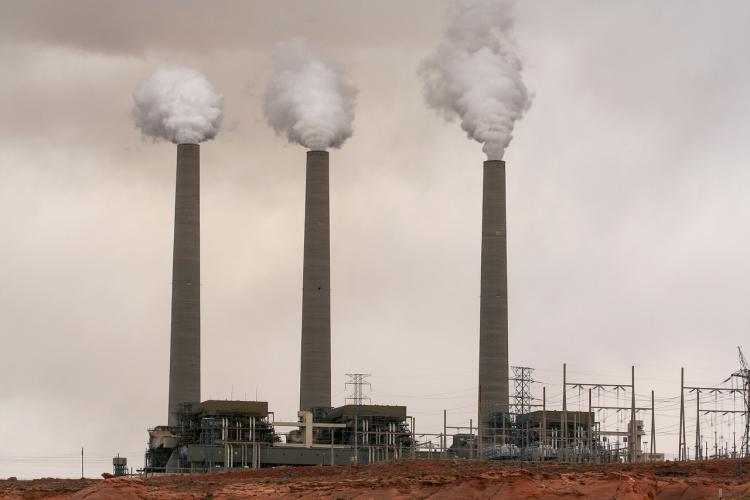We live in the dawn of the Anthropocene
How have humans changed the world? Let us count the ways.
On a rainy spring day, I spent several hours in Antelope Canyon, a slot canyon in colorful, striated sandstone cut by floodwaters, creating narrow and deep passageways and alcoves with fanciful, ornate walls. When I climbed out of the canyon's profound beauty, I was assaulted by the view of the Navajo Generating Station's smokestacks belching coal smoke into the sky, an ugly reminder that we live at the dawn of a geological epoch: the Anthropocene.
The Anthropocene epoch is a unit of geological time in which humans exert a dominant influence on climate and the environment, but we have not reached consensus on its starting point.

The Navajo Generating Station used local, high-sulfur coal to generate electricity, which contributed to acid rain in the Indian Peaks Wilderness and the haze filling the Grand Canyon. Photo by Jeff Mitton.
Some propose the megafaunal extinction, in which most of the large animal species became extinct shortly after hunters appeared, 15,000 to 13,000 years ago. Others favor the agricultural revolution and its numerous domestications of plants and animals 15,000 to 12,000 years ago. Many opine that the Anthropocene began with the industrial revolution in Britain from 1760 to 1840, while a few say it started with a bang at the detonation of the first nuclear device on July 16, 1945, near Socorro, N.M.
The Navajo Generating Station is on the Navajo Nation, just outside of Page, Ariz., but it has had impacts far away. It burns high-sulfur coal from the Navajo Nation, and this source of sulfuric acid contributes to the acid rain first discovered on Niwot Ridge and the Indian Peaks Wilderness in the 1970s by my colleagues, CU Professors William Lewis and Michael Grant.
But the Navajo Generating Station was also credited with 2 percent to 7 percent of the haze obscuring views of the Grand Canyon. Regrettably, the Navajo Station is not a unique source of pollution — we have more than 8,000 generating plants in the United States.
What is the justification for claiming that humans now have a dominant influence on climate, weather and environments? Here is a sample of my favorite examples.
I was born in 1947, and within my lifetime, the human population has grown from 2.4 to 7.6 billion — our population tripled! The activities of those people — heating and cooling buildings, agriculture, industry and recreation — has increased atmospheric carbon dioxide from 300 to 400 parts per million, an increase by one-third to an all-time high in recorded history. Atmospheric methane has increased 10 percent in the last three decades, and it has now reached a level three times higher than its average in the last 800,000 years. Carbon dioxide and methane are greenhouse gases that block the loss of heat from Earth during the night, causing climate warming.
Most people know about the comet that slammed into earth 65 million years ago, causing the extinction of the dinosaurs, but few appreciate that human activities increased the background extinction rate by 1,000 to 10,000 fold.
Because the temperature increase attributed to climate warming is dwarfed by the difference between summer and winter, many people assume it is inconsequential. But Glacier National Park gives testimony to the impact of warming. When it was established in 1910, the park had 150 glaciers, but today only 25 remain, and Glacier National Park will have no glaciers at all within two or three decades.
Water from melting glaciers has increased sea level by 7 inches since 1880, and by 2100 sea level is projected to rise another 7 to 23 inches. Coastal cities are already making plans to build sea walls to keep streets and subways from flooding.
Every river downstream of a water treatment plant has chemicals that disrupt fish development, producing abnormal intersexes with mixtures of male and female tissues.
I have watched the contrails of jet aircraft linger and merge into a cirrus haze that covers the sky. This is a new and widespread phenomenon, for the first commercial jet flight was in 1952, but today 102,000 flights per day leave contrails. The big jets introduce large amounts of water vapor and other emissions between 20,000 and 37,000 feet around the world.
Rain forests once covered 14 percent of earth's land surface, but more than half of the rain forests are gone and all could disappear within 40 years.
Professional biologists have reported that more than 300 species of plants and animals are moving north or higher into the mountains, and starting activities such as migration, flowering and nesting earlier in spring.
Buffalo no longer graze the extensive grasslands of the Great Plains, which have been converted to a patchwork of farms, ranches, towns and cities.
Our footprint on Earth and our impacts on forests, rivers and reefs are so great that we have triggered the sixth major extinction event: the Anthropocene Extinction. Most people know about the comet that slammed into earth 65 million years ago, causing the extinction of the dinosaurs, but few appreciate that human activities increased the background extinction rate by 1,000 to 10,000 fold. A conservative estimate reveals that 200 to 2,000 species are disappearing every year.
The Anthropocene is an age in which humans exert greater and greater impacts on land, the atmosphere, freshwater systems and the seas. We have done some wonderful things, but the unforeseen consequences of our actions are dire.

